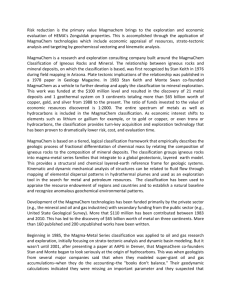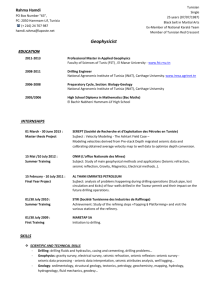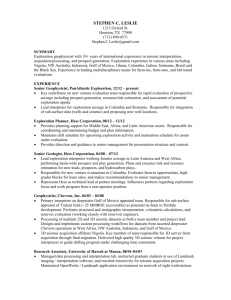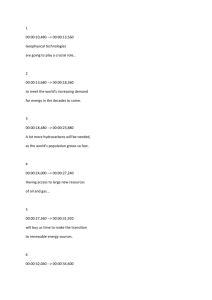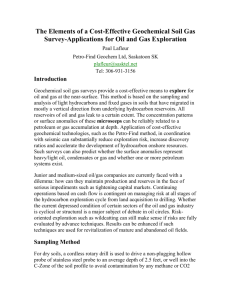Geochemical Soil Gas Surveys, Cost-Effective Exploration with Low
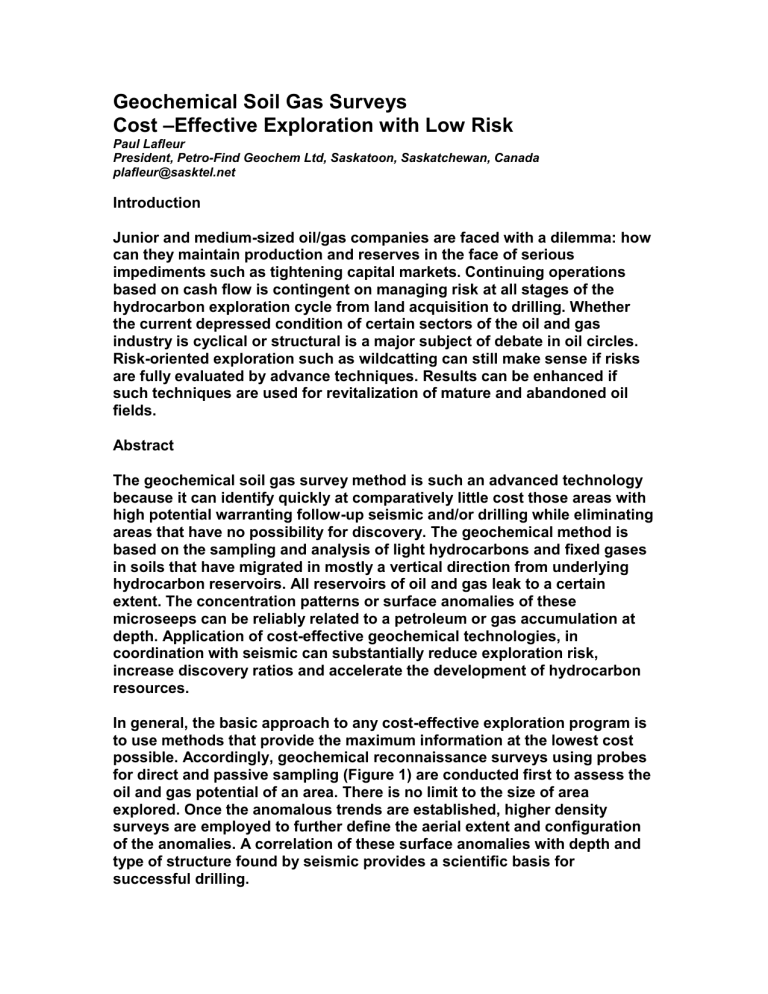
Geochemical Soil Gas Surveys
Cost
–Effective Exploration with Low Risk
Paul Lafleur
President, Petro-Find Geochem Ltd, Saskatoon, Saskatchewan, Canada plafleur@sasktel.net
Introduction
Junior and medium-sized oil/gas companies are faced with a dilemma: how can they maintain production and reserves in the face of serious impediments such as tightening capital markets. Continuing operations based on cash flow is contingent on managing risk at all stages of the hydrocarbon exploration cycle from land acquisition to drilling. Whether the current depressed condition of certain sectors of the oil and gas industry is cyclical or structural is a major subject of debate in oil circles.
Risk-oriented exploration such as wildcatting can still make sense if risks are fully evaluated by advance techniques. Results can be enhanced if such techniques are used for revitalization of mature and abandoned oil fields.
Abstract
The geochemical soil gas survey method is such an advanced technology because it can identify quickly at comparatively little cost those areas with high potential warranting follow-up seismic and/or drilling while eliminating areas that have no possibility for discovery. The geochemical method is based on the sampling and analysis of light hydrocarbons and fixed gases in soils that have migrated in mostly a vertical direction from underlying hydrocarbon reservoirs. All reservoirs of oil and gas leak to a certain extent. The concentration patterns or surface anomalies of these microseeps can be reliably related to a petroleum or gas accumulation at depth. Application of cost-effective geochemical technologies, in coordination with seismic can substantially reduce exploration risk, increase discovery ratios and accelerate the development of hydrocarbon resources.
In general, the basic approach to any cost-effective exploration program is to use methods that provide the maximum information at the lowest cost possible. Accordingly, geochemical reconnaissance surveys using probes for direct and passive sampling (Figure 1) are conducted first to assess the oil and gas potential of an area. There is no limit to the size of area explored. Once the anomalous trends are established, higher density surveys are employed to further define the aerial extent and configuration of the anomalies. A correlation of these surface anomalies with depth and type of structure found by seismic provides a scientific basis for successful drilling.
2
Soil gas surveys present unique field access problems depending on whether they are of the reconnaissance or high-density type or whether the pattern is grid or non-grid (Figure 2). Grid surveys are conducted in areas usually occupied by farmlands and ranches where surveyed roads provide easy access. However, a highly mobile sampling system with a small environmental imprint is required to access farmers’ and ranchers’ fields and pastures that may be fenced and in crop. This is also the case for nongridded areas such as forests and hilly glacial tills where access is usually by trails. Walking may be the only option to reach certain areas.
Cost-effective analysis requires a qualified chemical analyst and a high-end gas chromatograph to obtain good results (Figure 3). Also shown is a portable Micro-GC in a camp setting that is used for analysis of helium and hydrogen either for uranium exploration or natural gas associated with helium. To obtain a high linear dynamic the gas chromatograph must be properly calibrated each day with all the individual gases expected to be measured. To be cost-effective the GC must be equipped with an autosampler that can operate 24/7. Another requirement is a back-purge system which cuts the time for each analysis to 15 minutes. The analytes for the large GC are the light alkanes (C1-C5), alkenes (C2-C4) and CO2.
Of major importance to the explorationist is the surface location and pattern of the anomalous areas (Figure 4). For this purpose, two types of maps are produced – contour and bubble maps. In the mapping process, the coordinates and analytical data are downloaded to a computer and saved as an EXCEL file. A state-of-the-art software program is used to produce contour maps of the analytes and their ratios. From experience, scattered data points are best contoured with a triangular, non-gridded computer program. Contours are printed permanently on clear film for overlay on previously prepared georeferenced base maps. However, for some reconnaissance surveys where sampling points are very wide apart, contoured maps can be very misleading. The anomalous areas and trends of widely spaced data are best depicted by bubble maps as shown in the right picture.
Among the Alkanes, methane and ethane provide the most useful information on the type of reservoir an anomaly represents. For example, the picture on the right of a cross-plot of methane and ethane with an average value of 17 is indicative of condensates. This interpretation is supported by two other ratios (% methane in total light hydrocarbons; and
(C2/C3) X 10). Moreover, a high correlation ratio of R2=92 of methane with ethane shows the hydrocarbons including methane are thermogenic, except for a few outliers. The existence of C2+ (i.e. ethane + propane + butane) is also indicative of a thermogenic hydrocarbon reservoir.
However, methane stable carbon isotope analysis provides the only means to differentiate between biogenic and thermogenic dry gas. These
3 interpretations are important for a hydrocarbon exploration company who may decide not to drill even though seismic structures and geochemical anomalies coincide if it is determined that the predicted reservoir content, say natural gas, is non-economic because of marketing conditions or geographical location.
Pentane is also a good indicator of condensates. A cross-plot of methane and pentane as shown on the left of Figure 6 indicates three petroleum systems. Other ratios support this interpretation. In general, the ratios of
Alkenes to Alkanes are useful indicators of the extent of oil biodegradation and therefore a measure of whether an anomaly represents heavy or light oil. As n-alkanes are selectively degraded, the ratios of ethylene/ethane, propylene/propane and butene/butane all increase with progression of bacterial degradation.
There is no question that the main tool for oil exploration is seismic, which can locate structures by either 2D or 3D methods. While soil gas surveys can locate and determine the areal extent of a hydrocarbon reservoir from surface anomalies, it cannot identify structure or its depth –that is the role played by seismic surveys. However, seismic alone cannot ascertain whether such structures contain oil or natural gas without drilling (AVO is controversial). Seismic surveys find structures that appear to be excellent traps but are often found to be dry when drilled because either faulting has breached the reservoir allowing hydrocarbons to escape or the structure was not charged with hydrocarbons in the first place. A correlation of surface anomalies with structure provides a scientific basis for successful drilling (Figure 7).
Ideally, geochemical soil gas surveys should be conducted before any seismic because they are far less expensive, are a direct indicator of the existence of hydrocarbons at depth; and can reduce follow-up seismic costs (i.e. fewer and shorter transects if focused on only anomalous trends). Dry holes are avoided and exploration costs are substantially reduced with this approach. This approach leads to greater discovery and a major reduction of risk. Present day exploration requires a coordinated effort based on geophysics, geology and geochemistry if it is to be successful. Another main advantage of geochemistry over seismic is that it is not limited by the type of trap in which the hydrocarbons have accumulated. Soil gas surveys are especially useful in prospecting for stratigraphic pools, which may not be associated with easily discernable structural features.
Mature fields offer major but often overlooked opportunities for development of new oil and gas reserves. Increasingly, mature fields are being developed by horizontal drilling and hydraulic fracturing because of its lower risk and quick payback. However, the revitalization of mature or
4 even abandoned fields by this process can be assisted by geochemical techniques which can identify undrained portions (i.e. sweet spots), bypassed compartments and optimum edges of pools. A geochemical survey of a mature field typically shows different concentration patterns. In
Figure 8, the depletion of reserves is shown by blue and green areas while yellow and orange show undrained portions of the field, which represent good targets for drilling. The pattern shows compartmentalization by faults or facies changes.
With beginning of production, apical anomalies will change depending on the type of drive. Before drilling, light hydrocarbons migrate vertically in the direction of lower pressure to the surface where they form anomalous patterns. However, once a well begins to produce, the light hydrocarbons are short-circuited horizontally to the well bore or area of lower pressure, thus modifying the original apical anomaly. Dissolved gas reservoirs such as heavy oil deplete very quickly forming doughnut or halo types of anomalies around well heads. Oil fields with water and gas cap drives also show this effect at the surface but because of the uniformity of pressures, the depletion of apical anomalies will be more uniform over a longer period of time.
A C2+ contour map of an incised fluvial-river valley illustrates a lost compartment. Interpretation indicates two large channel deposits and one point bar (Figure 8). Seismic located the two main channel deposits but missed the point bar, a lost compartment. Soil gas surveys can be applied to assess complex faulted reservoirs that have been split into a number of compartments. Each compartment will require a dedicated production well to drain the hydrocarbons within it.
Conclusions
Continuing operations of junior and medium-sized oil/gas companies based on cash flow is contingent on managing risk at all stages of the hydrocarbon exploration cycle from land acquisition to drilling. Present day exploration requires a coordinated effort based on geophysics, geology and geochemistry.
Geochemical soil gas surveys provide a cost-effective means to explore in both mature and frontier areas. Mature fields offer major but often overlooked opportunities for development of new oil and gas reserves.
Increasingly, mature fields are being developed by horizontal drilling and hydraulic fracturing because of its lower risk and quick payback. However, the revitalization of mature or even abandoned fields by this process can be assisted by geochemical techniques which can identify undrained portions (i.e. sweet spots) and bypassed compartments as well as find the edges of reservoirs.
5
6
7
8

